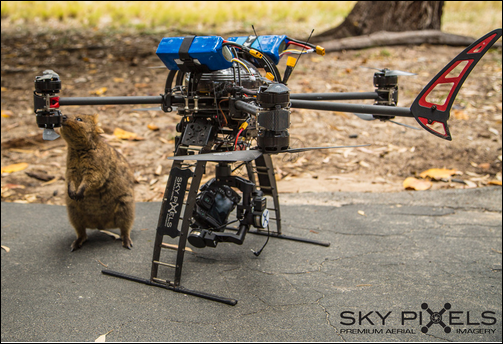Colin Bartley and Stefan Kraus were introduced to the 26th of November meeting of the Rotary Club of Pinjarra by James Tabor. Colin and Stefan are the owners of Sky Pixels, a West Australian-based video and photography production company which specialises in high quality cinematic images using drones and hand-held cameras.
Colin whose background is in graphic design, and Stefan who had been producing images using cameras attached to fixed-wing and drones, came together some five years ago when they identified an area in the advertising market that they could focus upon.
Both men are happily able to work in an area they are passionate about, with a love of flying and filming ensuring that their work has evolved to consistently provide a high quality product to their clients. "We are passionate about both flying and filming, and know the difference between aerial video and aerial cinematography. We always strive to capture the best images for our clients, according to their needs and instruction." Colin and Stefan are clearly proud of their body of work, which has been used for television, feature films, documentaries, television commercials, and more. Aerial photographs add an amazing perspective for marketing, advertising and promotion of many businesses, such as in tourism, real estate, events, and have also been used by agencies monitoring environmental changes within the landscape.
Additionally, the work of Sky Pixels has expanded to include Post-Production services which allow for the company to provide a complete package to the client.
Stefan told the Club members how his love of flying model aircraft evolved to adding a camera to his planes and taking photographs. When drones became more readily available, he progressed but soon realised that the drones available were not really suitable for his purpose. How to solve this? He built his own drone. Stafan did have a wry smile as he said much of the process was a real learning experience, with much trial and error. However, he has continued to manufacture his own machines and told us that his larger drones can carry payloads of 5 to 7 kilograms. This allows the use of heavier and more-sophisticated cameras and other ancillary filming equipment to be deployed when the drones are working.
In response to a question about "training" to fly a drone, Stefan related that in order to qualify and be licensed to fly commercially sized machines, he was required to pass the theory aspect of the Private Pilots Licence course overseen by the Australian Civil Aviation Safety Authority (CASA). Stefan believes this situation has recently changed, and that there is now a dedicated Commercial Drone Pilot's course being presented by CASA who remain the overseeing authority for this activity. Nonetheless, when flying a drone, "line-of-sight" is generally the way the flying happens. This means always "being able to see the drone with your own eyes", (rather than through a device, screen or goggles). CASA regulations direct that Recreational and Commercial drone operators must not fly over or above people or in a populous area. Drones are not permitted to fly at an altitude higher than 400 feet.
Sky Pixels' gear is built and modified to suit the varying demanding conditions that may be encountered during filming. Stefan pointed to one of the company's drones which he had brought to the meeting; the aptly named "Beast Octocopter". This drone's dimensions are 1100mm X 1100mm X 600mm; it weighs between 12kg-16kg (depending on the number of batteries used and the particular payload), and has 8 propellers 17 inches (430mm) in diameter.

Beast Octocopter with an interested bystander at Rottnest Island
Colin then showed a "behind the scenes" video from some of the company's work. A spectacular scene of the Octocoper flying through a narrow gorge at Karijini National Park was mesmerising, as was the pre- and post-production footage from an advertisement that featured the large outdoor sculpture installation located at the Edith Cowan University campus at Joondalup.
In general terms, the drone's batteries allow for 5 to 7 minutes flying and filming. The same set of batteries not only power the drone itself, but also the drone's electronic systems and those of the filming equipment. When filming in remote locations, therefore, a petrol generator is often working as hard as the drone to recharge batteries so that there is minimal down-time disruption caused by the lack of charged-up replacement batteries.
Colin and Stefan also have had to be innovative when filming scenes which require "crowd scenes". As mentioned previously, a drone is not permitted to be flown over or above people. The solution to this conundrum was the development of " Cablecam" ("Spidercam" to the sporting buffs), an innovation which has the camera and ancillary equipment attached to a cable suspended over the crowd, enabling filming to proceed safely without disruption of the crowd's activity.
A further variation is the Freefly Tero; a camera buggy that is a great tool with which to get immersive wide angle shots from a lower angle, but is equally as good for fast slow motion chasing.
After answering many questions from the members, Colin and Stefan were thanked for their talk by Adrian Fawcett, and wish good fortune in their endeavors.
